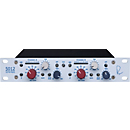Dual-channel mic pre featuring Neve custom input/output transformer designs.
The Rupert Neve Designs Portico 5012 is a dual channel microphone preamp that features Neve’s custom input and output transformers. In addition to individually selectable phase, mute, phantom power and a fully sweepable high pass filter, the Neve 5012 Duo mic pre incorporates a “Silk” circuit which yields the rich warmth and presence of the renowned classic designs.
Portico Series Awards:
Rupert Neve Designs has been honored three TEC Awards since its inception in 2005. The Portico 5042 “True Tape” Emulator won for achievement in the category of Signal Processing Technology/Hardware. The Portico 5015 Mic Pre/Compressor (#482645) won for achievement in the category of Mic Preamplifier Technology. The 5088 Discrete Analogue Mixer won for achievement in the category of Large Format Console Technology.
Rupert Neve Designs received the Mix Certified Hit Award in 2006 for the 5088 Console and the Portico Range.
Rupert Neve Designs received the Future Music Platinum Award for the Portico Range in 2007.
Microphone input
The Portico 5012 Duo preamp’s microphone input is balanced but not floating, being a variant of an instrumentation amplifier using a “Transformer-Like-Amplifier” (TLA) configuration with a toroidal common mode rejection low-pass filter that excludes frequencies above 150kHz. The TLA is followed by an actual input transformer permitting a full +25dBu input signal to be handled at unity gain without an input pad over the whole audio spectrum. This combines the advantages of both an electronically balanced and true transformer input. When the phantom voltage is switched off, this input serves as a very high quality line input with an impedance of 10,000 ohm.
Low noise, low distortion operation
Much care was given to designing the Portico 5012 Duo to produce as little noise and non-harmonic distortion as possible. Carefully implemented signal paths and Class A operation are a large part of the Neve 5012 mic pre’s sweet, whisper-quiet performance.
Why transformers?
The fine subtleties of circuit design relating to sonic performance are gradually becoming more clearly understood. For example, research has shown conclusively that frequencies above 20kHz affect the way in which humans perceive sound quality. But long before scientific evidence emerged, a substantial body of musicians and engineers knew that equipment with apparently the same technical measurements could sound very different.
Incredibly small amounts of musically dissonant, odd harmonics have a disastrous effect on the sound quality. Extraneous noise or interference that finds its way into a signal path seriously impairs performance of the whole chain.
Many control rooms make use of outboard gear that is not well protected from external signals. Poor grounding of such equipment can be a serious problem. Electronically balanced circuits, much used in modern equipment, can give very good measurements on the test bench but they do not provide adequate rejection of the stray fields found in every working environment.
Input and output circuits must be freed from ground dependence so that only the wanted signal enters and leaves the processing path. Transformers are the ideal solution. The sweet and silky sound of Neve’s classic old favorite consoles was achieved with big transistors and large high quality transformers. Rupert Neve Designs Portico modules achieve similar quality today without the bulk or the cost.
In order for modules to work together as would be expected (i.e. in a proprietary console configuration) without producing hum, RF interference, or other interactions, the connecting interfaces, grounding, levels and impedance must receive careful attention. Each Neve Designs Portico module is a complete integral signal processor that delivers its specified performance independently. This is one of the reasons Rupert Neve Designs uses transformers.
Controls:
Silk:
Much could be written about this feature. It gives a subtle option to enhance sound quality in the direction of vintage modules. The Silk button reduces negative feedback and adjusts the frequency spectrum to provide a very sweet and musical performance. Try it and make your own judgment.
Level Meter:
-30dBu to +22dBu with reference to the output
Mute:
Cuts of the output signal post metering and pre Buss Output. Be sure to mute the outputs before engaging phantom power.
High-Pass Filter:
The high pass filter is a valuable aid in any signal chain but particularly so in a microphone preamplifier. Signals between 20 and 250 Hz can be attenuated, leaving the range above this unaffected. This gets rid of building rumble, air handling motor hum etc.
Phantom Power:
Provides 48V phantom power to microphones
Buss Output:
The To Buss output is unbalanced and has a high impedance output. It is intended for use with the Portico Buss Amp/Monitoring modules. A TRS patch cord is used to connect the 5012 Buss output to one of these bussing modules. The Monitor connection is derived pre mute on the 5012 and will produce a signal at the output of the buss modules that is equal in level to that at the 5012 output. The Monitor output cannot be used for any other purpose.
Phase Invert:
Flips the phase of an incoming source 180 degrees
Bus Output
:
The Bus output is designed to feed other Portico Series modules with bus Inputs.
Rackmounting Porticos:
If you’d like to rackmount a single Portico, Neve offers the Half Rack Joining Kit (see #482654). Or to rackmount two Portico units, Neve offers its Horizontal Joining Kit (see #482653). Another option for mounting single half rack units is the Raxxess Universal Rack Shelf (see #421642).
Mr. Rupert Neve — The Grandfather Of Pro Audio
If anyone could be considered for the title, “Grandfather of Pro Audio,” the first name that would leap to mind would be Mr. Rupert Neve.
Recognized as the developer of the modern mixing console, Rupert’s handiwork is found in thousands of studios around the world.
In 1997, Rupert became one of a very few personal recipients of a Technical Grammy award. In awarding his Grammy, the Recording Academy acknowledged Rupert’s profound impact on the industry:
Rupert Neve Grammy Honors
For setting the standard for quality sound reproduction through his engineering and his innovative designs, which have made possible unparalleled advances in the quality of recorded sound; in recognition of his influence on a generation of audio designers; and for his dedication to purity of audio reproduction.
The morning following the amazing Grammy Awards ceremony in February 1997, Rupert and Evelyn Neve hired a stretch limo to take them to the airport. After all, for that day at least, Rupert was a star. Carrying the coveted Grammy Trophy in its distinctive blue Tiffany bag, they headed for security.
“What is this?” the security guard asked, puzzled by the strange image on her screen. “It’s our Grammy,” Rupert replied. The girl looked startled and in hushed tones said, “I’m so sorry sir. You’ll have to check this. We can’t carry ashes in the cabin.”
“No, no, no,” Rupert explained. “My Grammy – not Granny. Have a look if you like.” She opened it up and for a moment security at the airport came to a standstill as girls screamed and all gazed in awe at the beautiful replica gramophone. It was almost the best moment of the whole proceeding.
Mix Magazine Hall of Fame
In 1989, Rupert was inducted into the Mix Magazine Tech Awards Hall of Fame in recognition of his lifetime contribution to excellence in recording and sound.
An Elite Fraternity
In 1999 he was honored as “Man of the Century” by Studio Sound magazine. It is Rupert’s prized honor to have been selected by his peers in the Pro Audio business as number one Audio Personality of the 20th Century.
At the turn of the century, Studio Sound conducted a survey inviting readers to vote for the Top Ten personalities of the industry in various disciplines. The first was Audio Personality.
The Audio Century: Top Ten Audio Personalities of the 20th Century
1. Rupert Neve – champion of audio quality
2. Ray Dolby – household name
3. Sir George Martin – people’s producer
4. Willi Studer – tape machine pioneer
5. Colin Saunders – founder of SSL
6. Alan Blumlein — inventor
7. Georg Neumann – microphone Designer
8. Michael Gerzon – mathematician
9. Valdemar Poulsen — inventor
10. Les Paul – guitars and multitracks






Join the discussion
comments powered by Disqus